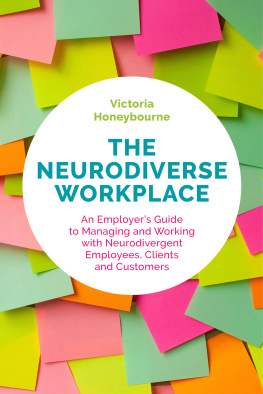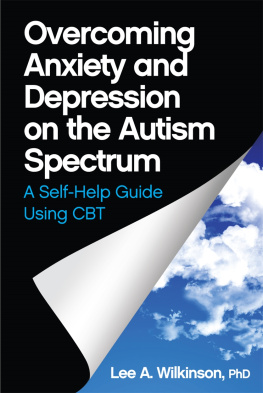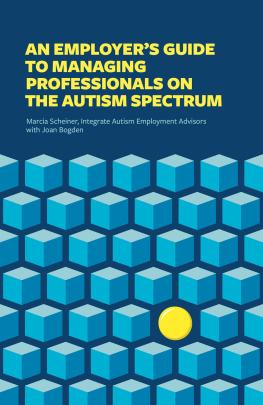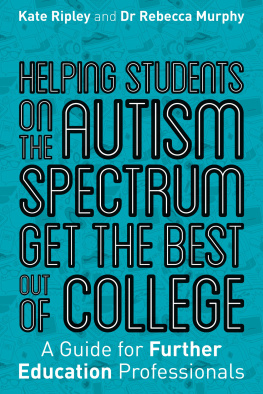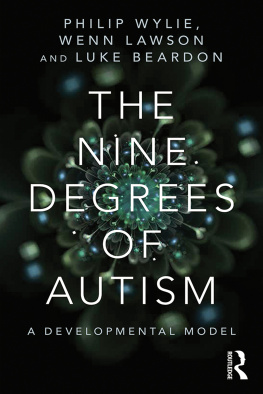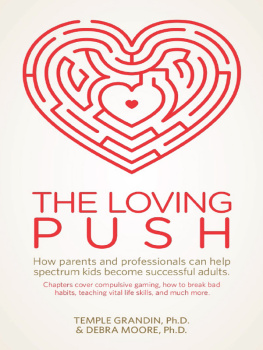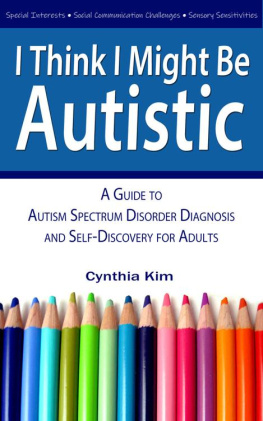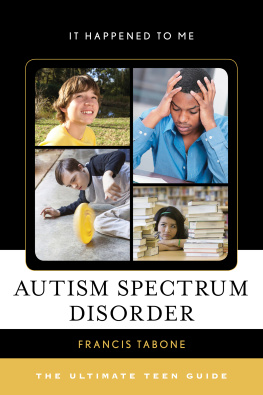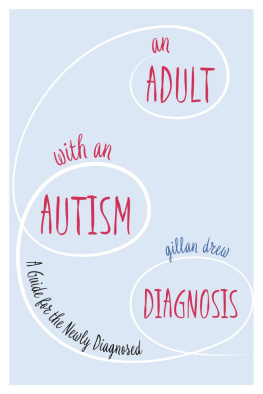
A PRACTICAL
GUIDE TO
HAPPINESS
IN ADULTS ON
THE AUTISM
SPECTRUM
A POSITIVE PSYCHOLOGY
APPROACH
Victoria Honeybourne

CONTENTS
INTRODUCTION
What does it mean to be happy? We use the word happy frequently I just want my children to be happy, Ill be happy when this week is over, Are you happy in your new job? but what exactly do we mean by happiness? Is happiness a short-term state (Im happy when Im playing tennis) or a longer-term condition (Im a happy person)? The very thing that makes one person extremely happy (going to a football match, reading a book, being alone...) might indeed induce a state of extreme unhappiness in another. But happiness, however defined, is something generally considered a positive state worth cultivating.
Every one of us experiences the world differently. We each interpret the world through our own unique eyes. This uniqueness makes life so wonderfully diverse but can also be what causes so many misunderstandings and difficulties at times. Individual uniqueness means that what will make each of us happy will differ too. All too often research indicates that individuals on the autism spectrum are more likely to be unhappy, depressed, anxious or worried than neurotypical others. Perhaps too often we assume that the problem lies within those individuals, rather than viewing happiness as the multi-faceted construct it is, influenced heavily by social, environmental and psychological factors.
This book is a guide to promoting happiness and wellbeing in individuals on the autism spectrum (including those with Asperger syndrome) using a positive psychology approach. Positive psychology is the scientific, evidence-based study of the positive elements of human existence such as strengths, positive emotions and positive coping mechanisms. This book also considers wider related issues, such as the fundamentals of wellbeing and the importance of not imposing a neurotypical view of happiness on autistic individuals.
AIMS OF THIS BOOK
This book provides a starting point for applying some of the findings of positive psychology when working with adults on the autism spectrum (for more detailed information about specific aspects of positive psychology, please see the Further Reading and Resources section). The following chapters aim to:
Demonstrate how findings from the positive psychology movement can be used or adapted with individuals on the autism spectrum in order to improve their wellbeing and happiness
Provide practical strategies and approaches for individuals on the autism spectrum to put into place in their own life
Provide practical strategies and approaches for professionals to use when working with individuals on the autism spectrum in a range of settings
Demonstrate the importance of not imposing a neurotypical view of happiness or current societal trends and values on individuals on the autism spectrum
Individuals on the autism spectrum can face a range of challenges in everyday life. Traditionally, success has been measured for individuals on the autism spectrum in terms of tangible, physical outcomes being in employment, for example, achieving a qualification, or living independently. Achieve those things, and the individual is deemed to be successful. Although these successes can be important, it does not necessarily follow that they automatically bring happiness and wellbeing too. An individual on the autism spectrum might be highly qualified, employed and live independently, but could simultaneously be extremely unhappy, unfulfilled, anxious and lonely. Research is beginning to show that success does not bring long-term happiness, but that being happy can increase the likelihood of success. This book is based on that philosophy: that individuals on the autism spectrum who have a good sense of wellbeing and happiness are in a far better position to be able to overcome any difficulties they might face, work towards their goals and make informed decisions based on their own strengths and values. This book explores the concept of happiness from various angles: How far does our internal self-talk affect our happiness? How do the people around us affect our happiness? What impact do the media have?
When it comes to lasting wellbeing and happiness, there are rarely quick fixes to change an individuals outlook overnight. The activities and strategies suggested in this book are not intended to be one-off tasks, but rather to be starting points to initiate discussion and new ways of thinking. These are ongoing strategies that can be developed and extended over time to meet individual needs and circumstances. This is not a book that aims to make autistic people any less autistic it is a book aimed at helping those on the autism spectrum to feel happier being who they are and to develop the resilience and skills needed to live an authentic life.
It is always difficult to design any book, resource or activity for individuals on the autism spectrum, for just that reason autism is a spectrum, and one that is constantly evolving, expanding and extending. Individuals on the autism spectrum are found across the ability range, are from a range of backgrounds and have a range of attitudes, experiences and goals. Each individual will be at a different starting point in their journey in understanding who they are and how they relate to the people and society around them. Therefore, not every activity in this book will be appropriate for every individual on the autism spectrum. Individuals, or professionals working with individuals, should choose those activities that are most relevant.
REMEMBER! The activities in this book are designed to help individuals increase feelings of happiness and wellbeing. They are not a substitute for professional mental health input and are not designed to support individuals experiencing significant mental health difficulties. Individuals with acute and significant mental health needs should ask for a referral to local health services as soon as possible to receive specialised input.
NOTE! If you are working with young people, A Practical Guide to Happiness in Children and Teens on the Autism Spectrum (Jessica Kingsley Publishers 2017) by the same author focuses on specific issues and activities for this age group.
WHO THIS BOOK IS FOR
This book is aimed at individuals on the autism spectrum who want a self-help guide to improving their happiness and wellbeing, as well as professionals working with individuals on the autism spectrum. Readers who might find this book useful include:
Individuals on the autism spectrum (including those with Asperger syndrome)
Autism mentors
Specialist autism workers
Adult education tutors and mentors
University disability officers and mentors
Speech and language therapists
Counsellors and therapists
Health professionals
Social care professionals
Most of the activities and tasks in this book require a verbal ability to respond and reflect. Therefore, the book is most suited for individuals on the autism spectrum who would traditionally fit the criteria of Autism Spectrum Disorder Level 1, Asperger syndrome or high-functioning autism, rather than those with significant co-occurring learning and language difficulties.
It is also important not to focus too much on diagnostic labels. Many of these activities have been adapted from strategies that have been shown to be beneficial with the general population. Many individuals can benefit from the suggestions in this book, even if they do not yet have a formal diagnosis of an autism spectrum condition, or do not quite meet formal diagnostic criteria. For that reason, many activities focus more on individuals gaining self-knowledge, rather than focusing on stereotypical autistic traits.
Next page

